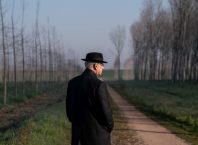“I love his openness and curiosity, his love/hate relationship with American cinema. His deep honor to great masters, from USA, Japan, France, Germany, Italy, and Portugal, ones that he has restored to public consciousness. I love Wim Wenders for his long time close support of young artists, as a judge, as a financial supporter and as someone who nurtures and opens doors.” said Renen Schorr, founder and director of the Sam Spiegel School for Film and Television, introducing famed German director Wim Wenders. Wenders’ visit, in honor of the school’s 20th anniversary, included a master-class, conversation with students, a press conference, and public screenings of his most recent film, Palermo Shooting.
Schorr also noted that Wenders is a strong supporter of Israeli film- as the President of the European film Academy, Wenders having agreed to accept Israel and the Palestinian Authority into the European Film Academy in 2003- “Since then, Israeli films have been competing and winning prizes. More than that, Israeli films have gained recognition, definition and a friendly harbor.”
Before the screening of Palermo Shooting, Wenders introduced two short films he had made: “Before I take you to Palermo, I wanted to take you to Africa”. The films were made in the town of Kabalo in the Congo. The first, called Invisible Crimes, is one of five short films by five different directors commissioned by Doctors Without Borders to commemorate the 20th anniversary of their Spanish organization: “They’re very modest people- they don’t want to be honored. But they would like to have a film made –not about their work, they’re too modest for that- but about some issues that are important to them. Doctors Without Borders have a list every year, they call it the ‘list of the Invisibles’. They are ten issues, diseases, conflicts, that they feel are overlooked by the world. So they gave to the five of us that list, and everybody took a subject and the subject that I picked was difficult, but I read information about it, and the more information I read the more I wanted to make a film about the subject. The subject was violence against women in areas of war. And the doctors have really taken it up as one of their major concerns, and they realized they had to treat it as a disease, a serious and growing disease.”
The 20 minute film is a comprised of interviews with women who have been beaten and raped by different factions in the conflicts in the region. Spare and quiet, the film’s most shocking aspect is the tone in which these women describe the horrors they’d been through. As Wenders said in a Q&A after the film: “I was shocked and completely destroyed at the end of the day, because the way they had told the stories was so matter of fact and without any self-pity. They had this unbelievable gentle melody in their voices.” Throughout the film, Wenders has the women slowly fade in and out of the scenery, while their melodic voices continue recounting their stories. It’s not only about these women- it’s about the disease itself, with hope that the stories will motivate people to act towards a cure.
The second film, War in Peace, is only 3 minutes long, and was Wenders’ addition to ‘Chacun son Cinema’, a collection of short films about cinema put together to celebrate Cannes’ 60th anniversary. It shows where the men of Kabalo spend their days: Watching movies. A DVD of Black Hawk Down is showing on a tv screen, with Wenders’ camera showing the faces of the children in the audience. “No light, pitch dark, the only way to actually shoot there was with consumer cameras, because they had night vision. They completely forgot about us.” We see their different reactions to the film, from excitement to horror. This led Wenders to expound on one his most fervent beliefs about cinema at the moment: “Although it is peace now, war is perpetuated and death is perpetuated and violence is perpetuated. These warriors, as soon as peace was there, they still were in war, and even these little boys who were born into peace, lived in a war zone every day, because they spend every day in the cinema [watching war films]. It throws a very different light on what films about war and violence do. The more I think about it, films cannot really distance themselves from what they show. So any war film with the greatest intentions –and there are only 2-3 examples of this- films that show violence perpetuate violence and films that show war perpetuate war. And there are almost no exceptions. Films are what they show, and it’s very hard to distance yourself and say you hate this while you’re showing this. So I see war films with different eyes after I saw these kids. I’m very militant now as far as violence in movies is concerned.”
Kabalo, incidentally, was once famous- “You might have read about it, because if you ever read Joseph Conrad’s Heart of Darkness, that’s where he wrote his book. Kabalo was the heart of Darkness, and when I was there, I thought that it should be the title of my movie, but of course I couldn’t call it that.”
In the Q&A after these short films (conducted by Emmanuel Wiztom), Wenders described at length his relationship to locality in films: “Everything starts for me with place. Maybe because I grew up in a country that had so little sense of place, I have developed a strong sense of place. All my films start with a place, and a desire to tell the story of that place. I would not know how to tell a story that could happen anywhere. I need to know the place even before I know the story; the story comes out of the place. The big blockbusters are almost by definition without a place, as they try to appeal to as many people as possible, and a concrete place would be in the way. One of the important functions of the camera is to let an audience know where they are. I have an architectural approach to cinema- it’s important that they know where they are. That they know where the door is, if it’s in a room, and that they find their way. I hate it when you see a film and you’re just completely lost. That’s why I really like wide shots –it was called in movie-language the ‘establishing shot’- and it was a fantastic tradition, but it’s gone down the drain, because these shots are by their nature very wide, and unusable on television. Most movies have internalized the language of television, moving closer and closer, elimination the wide shots. I like to know where is one in relation to the landscape, the street, the sun….I like to know where I am myself when I get there.”
The talk of place continued in the introduction to his newest film, Palermo Shooting– “I came back to Europe and I wanted to make a film that truly mattered to me. And I realized that I had not shot in my own country for a long time, and I had never shot in my hometown of Düsseldorf, which is maybe typical- your hometown is what you know best, and what you know best is sometimes the hardest to put your camera in. So I decided I was going to make a movie that starts in Düsseldorf.”
The main character in the film is Finn, a photographer leading a disconnected existence. He’s successful, popular in the art-world, has fun in the fashion world, drives fast cars and is perpetually scoring his own existence with superb songs that he listens to in his world-distancing head-phones. Even with those trappings, however, we meet him at an existential low point in his life. He’s been accused of manipulating his images and losing the truth of them. He’s been having nightmares about his mother. And he’s been seeing an ominous, Dennis Hopper shaped hooded figure. Finn (played by German punk singer Campino) decides that the answer lies in Palermo, where the plot thickens.
Watching this film, I was struck by a term Pauline Kael used to describe Wenders’ most popular and cited film, Wings of Desire. She called it Post-modern kitsch. That term does ring true for the last section of that film (not the sublime majority of it), but it fits Palermo Shooting like a glove- I found it to be full of supposed profundities that were generally banal and more than a little sappy. But that was only part of my reaction to the film. It offered no food for thought, but it was a film that felt alive, invigorated by its concept. That concept may be one that didn’t compel me, but it did compel Wenders, and I enjoyed the storytelling in this movie. It has a warm sheen to it, full of attractive sights and lighting. I did try to enter the film as being about photography, but aside from Wenders’ belief that photography is closely linked with death, the film was thin in that regard (though it did offer an interesting contrast to Jan Troel’s Everlasting Moments, where photography is equated with happiness). Aside from the ineffective Carpe Diem the film tries to push at the end, I wasn’t really sure what it was doing thematically. But it was a pleasantly confounding journey (it also carries superficial echoes of Nicholas Roeg’s classic Don’t Look Now, which is a film I love), full of terrific music, and, most importantly, full of vigor that, although inexplicable, pushed me along through this film.
In his introduction to the film Wenders raised a number of ideas that went into the making of the film. His points were lost on me in context of the film, but they are compelling points nonetheless, ideas that deserve to be presented here in full:
“I had this long dream of making a film about the photographer, because I felt that photography is a very central subject in our culture. We all take photographs with our mobile phones, or little digital cameras. We all have gotten used to making these disposable pictures, and I always felt that photographers were at the front of the huge cultural event in our civilization –the so called ‘digitalization’- they were the first ones to experience what that incredible change brought about. I’ve photographed my entire life, started when I was five years old, and I today can see the first reels of films I took when I was six years old. I still have that negative, of course, that negative has a lot of pictures that were no good. Shaky, too dark….a lot of these pictures, with anyone with a digital camera, would not be stored, they’d be immediately erased. Let’s face it- none of these pictures that are taken today are stored in the first place. I can look at my sheets when I was little today, and I can see the truth of that day- especially the bad pictures, because they tell you more. But there’s a chronology and a truth that cannot be erased. Kids today will not see their pictures because they will not exist anymore. The pictures that we all take today will be in an obsolete format in a couple of years, the storing system will be obsolete, people throw away their pictures when they have a new mobile phone. Photography has an altogether different meaning today. I wanted make a film remotely about that. The more I thought about it, I realized that if you were seriously making a film about a photographer, you could not avoid the subject of death.
There is the famous saying that ‘photography is watching death at work’ so I couldn’t portray a photographer, even in fiction, without approaching the subject of death.
So I started to develop that idea, and all my friends told me that you don’t make a movie about death, that is one of the big taboos. You can kill as many people as you want, you can kill them by the thousands, but you should not make death the subject of the film, that’s a no-no. And that truly pissed me off. They were right, of course, it is a subject that rarely shows up. I was discouraged a bit, and then I listened to my favorite music again, and I realized that death in blues and rock & roll was treated in a very different way than in movies. There are hundreds and thousands of songs with that subject, unabashed, with no fear. So I realized that if this was possible in blues, I should make a film and not be afraid of choosing that subject. So Death appears as a person.
I have to tell you one thing though. Because if you think of a film with a photographer, you can’t help thinking about Antonioni’s Blow-Up. No other film that deals with photography like this. So I showed Blow-Up to my cast and my crew. And once there was a character of Death in my film, there is only one film, even if you don’t want to refer to it actively, you cannot help to think about Bergman’s The Seventh Seal. So that’s the other film I showed to them. Then, as I was finishing my script, Ingmar Bergman died. And the next morning I read that Michaelangelo Antonioni had died, and that’s why the film is dedicated to these two. And now I’ve really told you too much. You don’t have to see the movie any more.”
Image credit: Zvika Portnoy





